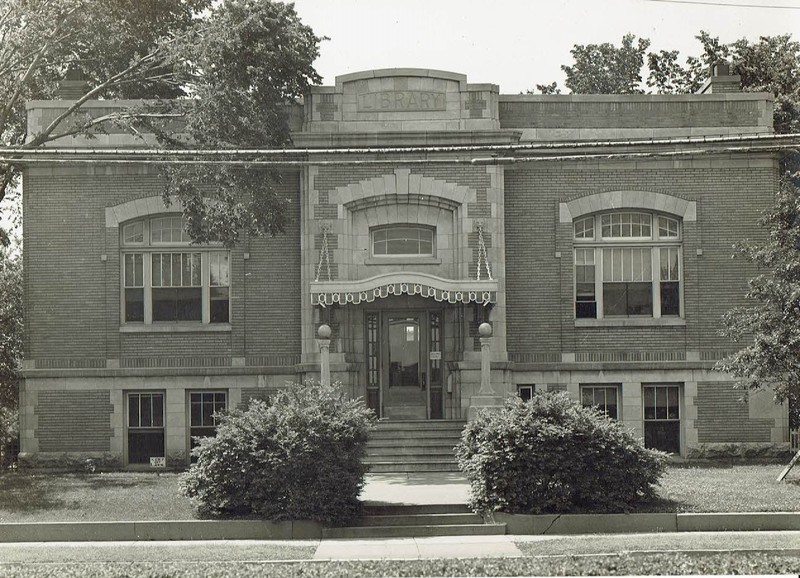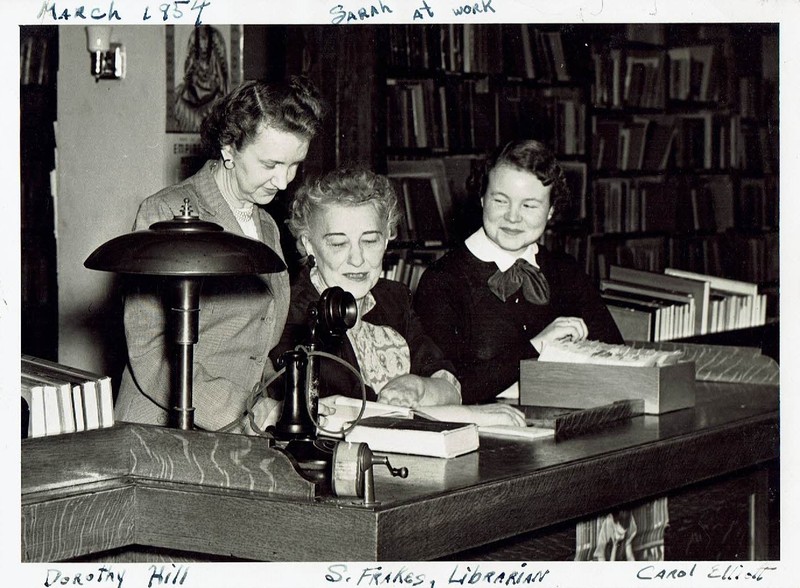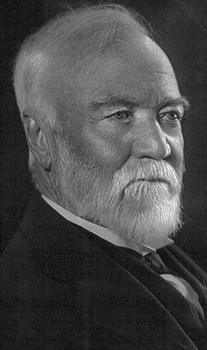Carnegie Building
Introduction
Text-to-speech Audio
This beautiful two-story building was completed in 1917 and housed the Nevada Public Library for eighty years. The Andrew Carnegie Foundation donated $17,500 for the building. Citizens of Nevada pledged tax money for upkeep and participated in fundraising to purchase the location lot. Although the building has changed hands and purpose, it is nearly the same as when it was first built.
Images
"Carnegie Library in the early 20th century, after it was built in 1917"

"Sarah Frakes and other library board members working at Carnegie Library"

Andrew Carnegie, 1835-1919

Backstory and Context
Text-to-speech Audio
Andrew Carnegie’s father was a weaver in Scotland; when he turned 13, his family moved to America. Carnegie came from the slums of Pittsburgh only to be a pivotal factor in America’s industrial rise. A couple of decades later, in 1900, he and his partner Henry Frick produced more steel than the entire British industry. After selling the company to J.P. Morgan in 1901, he contributed to society through philanthropy. Today, Carnegie is remembered for his generous gifts of music halls and libraries, like this building.
At the end of the 19th century, in Nevada, Missouri, people wanted Carnegie to endow a public library. Therefore, a group of women in Nevada went to the Mitchell Hotel to start organizing the library; Mrs. Rose Kimball was the president. A canvas provided books for the start of the library, and women financed new books through teas, socials, and bazaars. For the first couple of years, the library was in rooms provided by the Commercial Club in the Duck Block at the northeast corner of Washington and Cherry. However, the Courthouse was completed in 1908, so the County Court offered space to the Library. The library remained there until the Carnegie Building was erected. The public library would help those with limited needs in the community who could not afford books. Therefore, public libraries in rural and urban communities mattered because of needed education in those communities.
In 1912, R.A. Buckner, a prominent businessman in Nevada, Missouri, was in Hot Springs, Arkansas, when he met someone who worked for the Carnegie Foundation. Since the Foundation was planning to stop the library project, Buckner made a request immediately. The community-generated revenue to purchase the lot for the library through teas, socials, etc., organized by the Three Federated Clubs (Tourist, Progress, and Research). In March 1913, an election was held to vote for a tax to provide funds to sustain the new library; only sixteen men voted against it (women could not vote at the time). City Hall meeting minutes show that the bill became Ordinance no.1132. In the summer of 1915, the Nevada Board chose A.T. Simmons, from Bloomington, Illinois, to be the library’s architect.
James Bertram, the man in charge of the Carnegie library program, was demanding about library plans because people filled their libraries with luxury items instead of being used for their actual purpose-educating the public. Even though Bertram wanted certain ideas in the sketch to be changed, he let Simmons do what he wanted because his plans would preserve the nature of the library. The stone for the library was purchased from Phoenix Stone Company in Kansas City. Shortly after the stone was purchased, Judge Hoss was appointed as the head of the building committee, and the building opened on May 12th, 1917. The president of the library board was C.H. Jones. The librarian was Miss Sarah Frakes. Newspapers stated that the architecture was unique, and the interior was beautifully finished. The library’s exterior included arched windows and a marquee, while the interior had fireplace mantels and a baby grand piano.
On March 28th, 1954, a newspaper article stated a monument was placed in front of the building to honor Nevada clubwomen who started the public library. The women watched over 1,000 books in the Courthouse while they helped the town create a campaign for a library endowed by the Carnegie Foundation. At this time, Nevada’s public library had a collection of over 10,000 books and a leading number of magazines and volumes. However, Nevada’s public library later faced a budget shortage, which meant they had to close during certain days of the week and eventually move to a different building. As the Carnegie Building was put up for sale, the library was moved to 212 W. Walnut St. On October 9th, 1997, the Carnegie Building was sold by Randy Battagler (publisher of the Nevada Daily Mail) and his wife, Linda. Realtors like Ginny Nash donated their commissions from the sale of the old library building to the new library, which helped with the budget shortage. Later, Alan and Sarah Randall purchased the Carnegie Building, then in 2005, Greg and Melissa Hoffman bought it and made renovations. As of 2021, the Nevada/Vernon County Chamber of Commerce is located in the building.
Through Carnegie’s philanthropy, many urban and rural towns like Nevada gave education to everyone available, not just those who could afford an education. Public libraries are a staple of many communities because of their rich history and community effort through the years. Therefore, the preservation of Nevada’s old library and upkeep of the new library is vital for future education.
Sources
“A Monument to Pioneer Nevada Clubwomen.” The Nevada Daily Mail. March 28, 1954.
Andrew Carnegie. Nevada/Vernon County Chamber of Commerce. Accessed April 24, 2021. https://nevada-mo.com/the-carnegie-building/
Bushwhacker Musings: The Voice of the Bushwhacker Museum.
“Carnegie Grant Allowed for Purchase of Library.” Nevada Herald. June 29, 1980.
Philanthropy of Andrew Carnegie. Accessed April 24, 2021. https://library.columbia.edu/libraries/rbml/units/carnegie/andrew.html
Vernon County Historical Society Files
Vernon County Historical Society
Vernon County Historical Society
Wikimedia Commons
